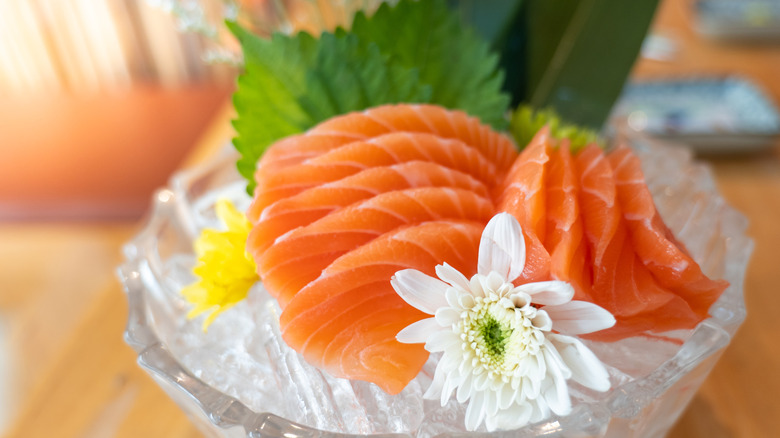Sushi Grade Vs Sashimi Grade Fish: What's The Difference?
When it comes to dishes that intimidate home cooks, few spring to mind faster than serving raw meat and fish — whether it's a tuna crudo for a salad, a classic steak tartare, or, of course, sushi and sashimi. Those latter two are just a few among a litany of Japanese culinary terms that are often bandied about by armchair chefs who don't really understand their meanings, and it can create a world of confusion for the would-be at-home sushi chef. There's a lot of information out there about serving raw fish, and not all of it is helpful.
Two of the most commonly used terms when talking about fish that are supposedly safe to eat raw are "sushi grade" and "sashimi grade." They're most often used by fishmongers to signify that certain fish they serve is — at least according to them — appropriate for raw consumption. But what's the difference between them?
The answer is, frustratingly: not very much, if anything at all. The two terms are commonly used interchangeably, with the only difference sometimes being that "sashimi grade" fish is often marketed as the best type of fish for sashimi, referring to particular cuts with a slightly higher fat content (think fatty tuna or salmon belly). At the end of the day, though, there isn't really much of a difference — so if you're agonizing over the two, don't fret!
What do sushi grade and sashimi grade mean?
Though they're most often used to refer to fish that's safe to eat raw, the terms "sushi grade" and "sashimi grade," technically speaking, mean nothing at all. In essence, they're just marketing gimmicks to promote the sale of specific types of fish to both consumers and restaurants. There's understandably a lot of anxiety attached to eating raw protein, and back in the early 2000s, fish suppliers (in an effort to boost sales) started using the terms to allay that anxiety. The reference to sushi or sashimi in the name was simply chosen because that was (and continues to be) the most familiar setting to see raw fish served.
The use of the word "grade" points to other food quality grading systems — like the scale the USDA uses for beef, for example — implying that the food you're getting has passed some kind of rigorous inspection and has been deemed to be of the highest quality. It makes you feel better about buying it — and it means fish markets can justify charging you a premium. The reality is, though, there's no such grading system for fish. The FDA does provide guidelines for how to safely prepare fish to eat raw, but there's no legal requirement for sellers to label fish as "sushi grade" in accordance with them. So really, the marker of "sushi grade" or "sashimi grade" is only worth as much as the fishmonger that uses it.
What's the difference between sushi and sashimi?
Though the terms "sushi grade" and "sashimi grade" are interchangeable (and are, in reality, equally meaningless), sushi and sashimi themselves aren't interchangeable at all. Though they're often lumped together, they actually refer to completely different culinary techniques. Sashimi is the Japanese term for sliced protein meant to be eaten raw — usually, but not always, referring to fish. In fact, in Japan, you can quite easily find beef or even chicken sashimi. So the term "sashimi grade" would imply that the fish in question is of sufficient quality (or has been treated appropriately, like freezing for a certain period of time to ensure there are no parasites present) to eat raw.
Sushi, in actuality, has nothing to do with fish at all. Technically, sushi refers to a particular method of preparing rice by soaking it, then seasoning it with a vinegar and sugar solution. The rice is then served with either a raw or cooked accompaniment — that can be raw fish, sure, but it can also be cooked protein, vegetables, or even egg. There's no need to eat sushi with fish at all! So next time you find yourself buying "sushi grade" fish, just make sure you're getting it from a supplier you trust — as long as you do, you're likely to be fine.



